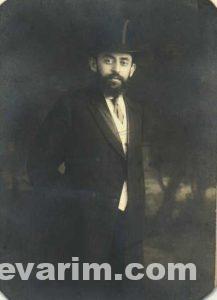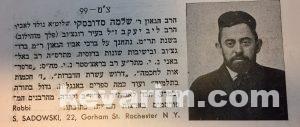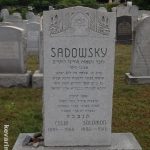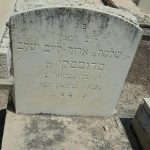Rabbi Shlomo Sadowsky
שלמה ב"ר ליב יעקב
Rav, Rochester, New YorkDate of Death:
Thu. October 31, 1946 -
Chesvan 6 5707
Anyone with biographical information is asked to please send it in.
See CONTACT page for details. Thank you.
Directions to Kever: While originally buried at the Britton Road Cemetery in Rochester, NY, Rabbi Sadowsky was later reinterred at the Tiberias Ancient Jewish Cemetery (Old Jewish Cemetery in Tverya) c.1950. The cemetery is located at the entrance of the city alongside the Sea of Galilee (Kinneret) and is always open. There are great tzaddikim buried at the cemetery among them Rebbe Menachem Mendel of Vitebsk and Rebbe Avroham of Kalisk, Location: Needed
Name Listed on Cemetery Database: Name listed on marker: Solomon Sadowsky
Biographical Notes:

Photo Caption: Rabbi Shlomo Sadowsky, Credit: MCA

Source: Needed

Credit: IFJCAH
« Previous: Rabbi Shlomo RoodmanNext: Rabbi Yissachar Dov Lissauer »





Rabbi Sadowsky was a son-in-law of Reb Shlomo Chaim Kutin of Lubavitch, as mentioned in the third chapter of Rabbi Yisroel Jacobson’s memoir Zichron L’Bnei Yisroel.
From Rogachov to Albany and to Rochester
Harav Shlomo Sadowsky, zt”l, was born in Rogachev (Rahachow, Belarus) on 3 Sivan, 5639/May 25, 1879 to Harav Aryeh Leib Yaakov (of Yanovich/Janavičy, belarus), a Rosh Mesivta in that town, and Feiga Rivka. The family were staunch chassidim of Chabad, and his grandfather Reb Ezra was close to the Baal Hatanya and the Mittler Rebbe, zy”a.
At a young age, he learned in a yeshiva in Kovna, and then became one of the first talmidim of the Yeshivas Tomchei Temimim in Lubavitch. At the age of eighteen, he transferred to Yeshivas Tomchei Temimim in Zembin (Ziembin, Belarus) in 5758/1898. A short time later, in 5660/1900, he was appointed to deliver shiurim in the yeshiva.
He married Tzirel (Celia) Kitain, the daughter of Reb Shlomo Chaim, who served as the leader of the shochtim in Lubavitch.
Rav Sadowsky immigrated to the United States in 1905 and served as a rabbi in Albany from 1905 until 1910. Although he had many supporters in the city, there were those who opposed him, and made life difficult for him. Harav Dovid Rackman, zt”l, in his Sefer Chanah Dovid, relates that he, too, was on the receiving end of the wrath of many of the Jewish residents of Albany, and Rav Sadowsky quipped, “I understand why I have some detractors; since I have some who support me, there must be some who oppose me. But Rabbi Rackman does not have any supporters, so why should anyone bother and disparage him?”
In 1911, he was invited by the Orthodox shuls in Rochester, NY, to become the chief rabbi of the city, and he arrived for Shabbos Nachamu. He served as the Rav in Agudas Achim-Nusach Ari, Congregation Beth Israel, Beth Hakenes Hachadesh and Nusach Sefard Anshei Vollin, and as an excellent orator he was well accepted.
As chief rabbi, he oversaw all communal activities, and one of his first projects was to reorganize the kashrus situation with the meat production in the city. All the meat sold by the butchers in Rochester would be slaughtered under the supervision of the Vaad Hakashrus (Rochester Hebrew Dietary Association) and only by shochtim approved by the Vaad. A small surcharge was added to the price of meat to pay for the shochtim and the Vaad’s supervision. With the approval of eight local congregations, he organized a Vaad Hakashrus, and invited Harav Gavriel Zev (Velvel) Margolis, zt”l, to come to Rochester and participate in the founding of the Vaad. Rav Velvele came in December 1911, and studied the rules of the Vaad, and approved of them. (See Clarion Call, March 1, 2023)
Although the Vaad functioned well for two years, but when a butcher brought in an outside rabbi, who was not learned, and began using their own shochet under this rabbi’s supervision. Although the Vaad had the backing of Rav Velvel, who was considered one of the foremost poskim in America at the time, the butcher called in Rabbanim from other places who backed the breakaway shechitah. Rav Sadowsky penned a letter to Harav Yosef Rosen of Dvinsk, zt”l, the Rogatchover Gaon, who responded by supporting the Vaad. (The letters were published by Rav Sadowsky in his Sefer Parpara’os Lachachmah Vegufei Halachos.)
In 1912, he helped found the Jewish Children’s Home of Rochester which served as an orphanage, and inn 1916 he helped establish Beth Hatevilah, the first communal mikvah in city of Rochester.
Rav Sadowsky served as the chairman of the American committee who worked to save the Raayatz, Harav Yosef Yitzchak of Lubavitch, zy”A, who was arrested in 1927 and sentenced to death for his activities spreading Torah and Yiddishkeit in Russia. The committee worked to convince American political leaders to register their complaints with the Communist government, and eventually the Raayatz, whose sentence had been commuted to exile, was eventually freed.
In addition to his membership in Agudas Harabbanim, Rav Sadowsky served as the vice chairman of Agudas Hatemimim of Chabad and raised substantial funds for Yeshivas Tomchei Temimim and Yeshiva Toras Emes. He was a member of the board of directors of Agudas Chasidei Chabad of America, and participated in its Committee for Out of Town. Rav Sadowsky delivered a shiur in Sefer Tanya and spoke at seuda shelishis each week as well.
In 5678/1917, Rav Sadowsky published Parpara’os Lachachmah Vegufei Halachos in which he included drashos on Sefer Bereishis and several halachic responsa. In 5688/1928, he published Drush Aseres Hadibros in which he explained how each one of the Aseres Hadibros were given to eradicate false beliefs prevalent in the past as well as in the present. In addition to these sefarim, he contributed Torah articles to the Yagdil Torah and Hapardes monthly publications, and authored several biographies in English about the lives of the Tana’im.
Rav Sadowsky was niftar on 6 Cheshvan, 5707/October 31, 1946. He was originally interred in the local cemetery but was reinterred in the ancient cemetery in Teveria in 5710/1950.